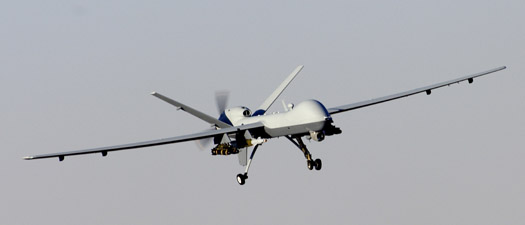

The unblinking “Gorgon Stare,” the Air Force’s new sensor package for aerial drones like the MQ-9 Reaper, is billed as one of the most game-changing intelligence tools to ever hit the modern battlefield: a nine (or more) camera array offering city-wide views of an area in real time simultaneously to dozens of soldiers on the ground. But a leaked draft memo reportedly reveals that initial tests by the Air Force show it doesn’t work quite so well, citing 13 serious flaws in the system.
Gorgon Stare was supposed to change the nature of counterinsurgency, offering big-picture views of an area to more soldiers than ever before, making each drone equipped with the system an order of magnitude more effective than it was previously. With five electro-optical and four infrared cameras packed into each array, the system was designed to stitch a broad mosaic together, allowing several commanders on the ground to simultaneously grab slices of that bigger picture. In other words, battlefield commanders are salivating for something like Gorgon Stare.
But, according to information generated by the 53rd Wing at Eglin AFB and obtained by Danger Room through military analyst Winslow Wheeler, Gorgon Stare isn’t all its cracked up to be, at least not after one round of tests. Everything from the video stitching (which leaves large black triangles in the ballyhooed “city-wide” view) to the quality of the IR night imagery is sub-par. Even the physical placement of the sensor pod is problematic, allowing the nose-mounted ranging laser to accidentally blind the Gorgon Stare cameras.
Perhaps the biggest problem discovered by the 53rd Wing: the new system has trouble finding and tracking targets on the ground, particularly moving vehicles and dismounted humans. The needs of counterinsurgency dictate that an effective aerial surveillance system must be able to track vehicles through a cityscape and, ideally, track individual humans on the ground once they dismount their vehicles. But a slow frame rate—its cameras broadcast at two frames per second by design to cut down on data transfer—and poor resolution (just half that of a normal drone camera) make such functions difficult if not impossible.
To be fair, Gorgon Stare has completed its first round of tests, not its last. After the airing of the aforementioned draft report the Air Force released a statement last night, declaring that the 13 problems noted fall into three broad operational categories, and that fixes are being devised for all three that should keep Gorgon Stare on schedule for deployment.
That schedule aims to have the new system operating in-theater this year, and the Air Force may very well adhere to that schedule. But whether or not Gorgon Stare will be the sharp, panoramic, unblinking eye that was advertised is another question entirely.
Update: Danger Room has posted a more in-depth review of the Air Force’s official response to these claims of Gorgon Stare’s deficiencies as well as some additional background on the program and the high–perhaps overly-hyped–expectations placed upon it.
